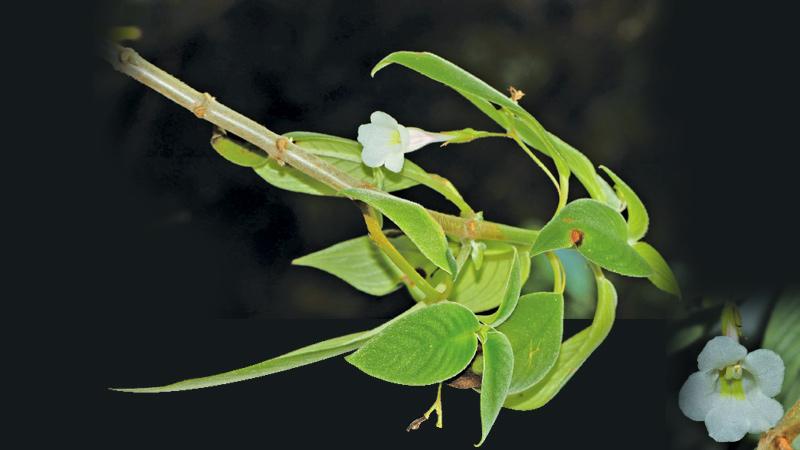
There is no other creation as wonderful as nature. What happens in nature is unbelievable, but in order to experience those wonderful events, everyone must truly learn to live with nature. By doing so we can notice even the most subtle changes that take place in it.
 Affirming this, a group of researchers have been able to discover a rare species of plant that has been recorded only from the Hiniduma area in the Galle District of the Southern Province, in the Meegahatenna, Nawalakanda Forest System in the Walallawita Divisional Secretariat Division in the Kalutara District of the Western Province.
Affirming this, a group of researchers have been able to discover a rare species of plant that has been recorded only from the Hiniduma area in the Galle District of the Southern Province, in the Meegahatenna, Nawalakanda Forest System in the Walallawita Divisional Secretariat Division in the Kalutara District of the Western Province.
The plant, scientifically known as Henckelia Wijesundarae, was first identified by Dr. Subhani Ranasinghe, the current Deputy Director of the National Herbarium of the Peradeniya Botanical Gardens, in a study conducted in 2016 in the Hiniduma area in Galle.
Hiniduma
Given the fact that this plant had not been recorded anywhere else in the country since then, it had been identified as a plant endemic to the Hiniduma area.
 However, after the discovery of this plant in Nawalakanda by Peshala Pasan Karunaratne, an environmental researcher who is engaged in the study of plant species, Bathiya Gopallawa, a former official of the Peradeniya Botanical Gardens National Herbarium and a researcher on plant species, identified the plant as Henckelia Wijesunde.
However, after the discovery of this plant in Nawalakanda by Peshala Pasan Karunaratne, an environmental researcher who is engaged in the study of plant species, Bathiya Gopallawa, a former official of the Peradeniya Botanical Gardens National Herbarium and a researcher on plant species, identified the plant as Henckelia Wijesunde.
Later, Himesh Dilruwan Jayasinghe, a plant expert, conducted a field inspection in Nawalakanda and confirmed that the species found in Nawalakanda was Henckelia Wijesundarae.
The name of the plant in Sinhala is yet to be ascertained and as it is endemic to Sri Lanka, there is no name for the species in English or any other language either.
Henckelia Wijesundarae has been scientifically named in honour of Prof. Cyril Wijesundera, who is currently a Researcher of the Institute of Fundamental Studies in Kandy and former Director General of the Peradeniya Botanical Gardens.
This plant, which belongs to the Genus H Wijesundarae of the genus Henckelia of the Gesneriaceae family in the plant kingdom, was first recorded in 2008.
Species
Following the discovery of this plant in the Hiniduma area in 2008, the species, following researches conducted in 2008 and 2013, was identified as Henckelia Walkerae.
Further research conducted by Dr. Ranasinghe, in 2016 revealed that this species is not a genus of H. Walkerae and renamed it as Henckelia Wijesundarae.
The research paper related to this finding was published in the August 2016 issue of Willdenowia, an international botanical journal based in Germany.
A number of 56 species of the genus Henckelia have been reported from India, Sri Lanka, the Himalayas, and Southeast Asia (excluding Malaysia and Thailand).
Of these, eight species are recorded from Sri Lanka and seven of them are endemic species. The plant specimens for this research were obtained from an altitude of 208 m in the forest behind the Hiniduma Nugagala Forest Hermitage.
Plants
However, since then it has not been found anywhere else and this species was considered to be endemic to the same place and with the discovery of it in Nawalakanda in 2021, the endemic record changed.
Very few of these plants were found at the Nugagala area and very few in the Nawalakanda area where the plant was discovered in 2021.
Researchers believe that this species may have been more widespread in the past.
Evidence that this was prevalent in the Kalutara district before 1850 has been in the possession of researchers since the time of research on this plant, and with this new discovery, the evidence have confirmed this.
Accordingly, it is noteworthy that this plant species was recorded in Kalutara district after about 170 years.
Researchers predict that the plant will lose habitat in clearing land for tea cultivation and human habitation, and that this will be further endangered in the future as the forest density continues to decline.
They also suggest that the plant be classified as “extremely endangered” and included in the Red List of Threatened Species.
The Nawalakanda Forest System where this plant was found is spread over the 849- D Bogodakanda Grama Niladhari Division in Walallavita, Meegahatenna area.
Study
The Nawalakanda Forest System is also a collection of small forests between human settlements with lowland wet zone forest features such as Sinharaja and Kanneliya.
No formal scientific study has been conducted on this small forest system, which is home to a number of extremely rare plant and animal species, and it is believed that if such a formal study could be carried out, many previously unknown species could be identified.
Therefore, formal knowledgeable experts and researchers should better conduct studies on this forest system and adopt conservation practices that take into account its biodiversity and scientific value.
As this forest is located in a village where human activities are prevalent, the villagers should be properly informed and steps should be taken to protect this small forest so that such rare and valuable plant species can be protected and inherited into the future world.
